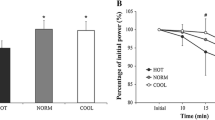Abstract
We tested the hypothesis that the prolonged elevated plateau of esophageal temperature (T es) following moderate exercise is a function of some exercise-related factors and not the increase in heat content andT es during exercise, by comparing the response to increaseT es during exercise (endogenous heating) and warm-water immersion (exogenous heating). Nine healthy, young [24.0 (1.9) years] subjects performed two separate experiments: (1) 15 min of treadmill exercise at 70%\(\dot VO_{2max} \) and 15 min rest in a climatic chamber at 29°C, followed by 15 min of immersion in a 42°C water bath and a further 60 min of recovery in the climatic chamber [exercise-water (EW)]; and (2) 15 min of immersion in a 42°C water bath followed by 60 min of recovery in the climatic chamber [water-only (WO)]. Esophageal (T es) and skin (T sk) temperatures were recorded at 5-s intervals throughout. TheT ea at which the forearm to finger temperature gradient (T fa-T fi) abruptly decreases was used to identify the threshold for forearm cutaneous vessel dilation (Thdil) during exercise. Pre-exerciseT es values were 36.64°C and 36.74°C for EW and WO respectively. The EW post-exerciseT ea value fell to a stable level of 37.12°C and this value differed by 0.48°C (P < 0.05) from baseline, but was similar to Thdil (37.09°C). Despite a 1.2°C increase inT es during the subsequent warm-water immersion,T es returned to the post-exercise value (37.11°C). The WO post-immersionT es fell to a stable plateau of 36.9°C, which was not statistically different from the pre-immersion Tes. The data for both warm-water treatments support the hypothesis that increases inT es and heat content alone are not the primary mechanisms for the post-exercise elevation inT es and Thdil. These data also support our previous observation that the exercise-induced elevation in Thdil persists into recovery.
Similar content being viewed by others
References
Brengelmann GL, Wyss C, Rowell LB (1973) Control of forearm skin blood flow during periods of steadily increasing skin temperature. J Appl Physiol 35:77–84
Fortney SM, Vroman NB (1985) Exercise, performance and temperature control: temperature regulation during exercise and implications for sports performance and training. Sports Med 2:8–20
Horowitz M (1990) Thermoregulation under conditions of impaired body fluid/osmotic balance in mammals. J Basic Clin Physiol Pharmacol 1:267–276
Houdas Y, Sauvage A, Bonaventure M, Guieu JD (1973) Thermal control in man: regulation of central temperature or adjustments of heat exchanges by servomechanism? J Dynamic System and Measurement Control 95:331–335.
Johnson JM, Park MK (1981) Effect of upright exercise on threshold for cutaneous vasodilation and sweating. J Appl Physiol 50:814–818
Johnson SC, Ruhling RO (1985) Aspirin in exercise-induced hyperthermia - evidence for and against its role. Sports Med 2:1–7
Kaciuba-Uscilko H, Kruk B, Szezyaczewska M, Opaszowski B, Stupnicka E, Bicz B, Nazar K (1992) Metabolic, body temperature and hormonal responses to repeated periods of prolonged cycle ergometer exercise in men. Eur J Appl Physiol 64:26–31
Mekjavic IB, Bligh J (1989) The core threshold for sweating. Can J Physiol Pharmacol 67:1038–1044
McKjavic IB, Rempel ME (1990) Determination of esophageal probe insertion length based on standing and sitting height. J Appl Physiol 69:376–379
Molnar GW, Read RC (1974) Studies during open-heart surgery on the special characteristic of rectal temperature. J Appl Physiol 36:333–336
Nadel ER, Fortney SM, Wenger CB (1980) Effect of hydration state on circulatory and thermal regulations. J Appl Physiol 49:715–721
Nishiyasu T, Shi X, Mack GW, Nadel ER (1991) Effect of hypovolemia on forearm vascular resistance control during exercise in the heat. J Appl Physiol 71:1382–1386
Pergola PE, Kellogg DL, Johnson JM, Kosiba WA (1994) Reflex control of active cutaneous vasodilation by skin temperature in humans. Am J Physiol 266:H1979-H1984
Proppe DW (1981) Influence of skin temperature on central thermoregulatory control of leg blood flow. J Appl Physiol 50:974–978
Rowell LB (1974) Human cardiovascular adjustments to exercise and thermal stress. Physiol Rev 54:75–159
Rubenstein EH, Sessler DI (1990) Skin-surface temperature gradients correlate with fingertip blood flow in humans. Anesthesiology 73:541–545
Sawka MN, Wenger CB (1988) Physiological responses to acute exercise-heat stress. In: Pandolf KB, Sawka MN, Gonzalez RR (eds) Human performance physiology and environmental medicine at terrestrial extremes. Benchmark, New York, pp 97–152
Shiraki K, Konda N, Sagawa S (1986) Esophageal and tympanic temperature responses to core blood temperature changes during hyperthermia. J Appl Physiol 61:98–102
Thoden JS, Wilson BA, MacDougall JD (1992) Testing aerobic power. In: MacDougall JD, Wenger HA, Green HJ (eds) Physiological testing of the elite athlete. Movement, New York, pp 39–54
Thoden JS, Kenny GP, Reardon F, Jette M, Livingstone S (1994a) Disturbance of thermal homeostasis during post-exercise hyperthermia. Eur J Appl Physiol 68:170–176
Thoden JS, Kenny GP, Livingstone S (1994b) Post-exercise defence of thermal homeostasis. In: Frim J, Ducharme MB, Tikuisis P (eds) Proceedings of the Sixth International Conference on Environmental Ergonomics. Scientific Information Center, Defence and Civil Institute of Environmental Medecine, North York, Canada, pp 238–239.
Webb P (1995) The physiology of heat regulation. Am J Physiol 268:R838-R850
Wenger CB, Roberts MF, Stolwijk JAJ, Nadel ER (1975) Forearm blood flow during body temperature transients produced by leg exercise. J Appl Physiol 38:58–63
Zeisberger E (1990) Central modulators of thermoregulation. J Basic Clin Physiol Pharmacol 1:277–289
Author information
Authors and Affiliations
Rights and permissions
About this article
Cite this article
Kenny, G.P., Giesbrecht, G.G. & Thoden, J.S. A comparison of human thermoregulatory response following dynamic exercise and warm-water immersion. Europ. J. Appl. Physiol. 74, 336–341 (1996). https://doi.org/10.1007/BF02226930
Accepted:
Issue Date:
DOI: https://doi.org/10.1007/BF02226930




